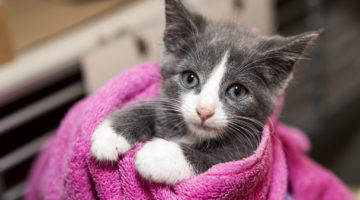Warm temperatures can put kittens in serious peril, but if people, shelters, and communities step up to tackle the problem together, we can hopefully turn kitten season into foster season.
Kitten Season — the annual high-breeding period that runs through spring and summer — is a time of tremendous challenges for young cats, whether they’re inside or outside a shelter. And the younger they are, the more difficult it is for them to simply stay alive.
One of those kittens is Misha. Born at the end of March, Misha was four weeks old when she was brought to Animal Care Centers of NYC’s Manhattan shelter. Suffering from a fractured right hind leg, the tiny black kitten – weighing only seven ounces – was transported to the ASPCA Kitten Nursery and assigned a foster home until she is old and big enough to spayed. From there, she’ll go back into foster until she is ready for adoption.
Kittens under eight weeks old, like Misha, are the most threatened because they are too young to survive without constant care due to their vulnerable immune systems. And shelter kittens under five months are at risk of euthanasia because of their sheer numbers. In Los Angeles, 90% of the nearly 34,000 kittens entering L.A. County and L.A. City shelters each year come in during Kitten Season. In New York City, 84% of the felines who enter Animal Care Centers of NYC during this period are kittens. All of these at-risk kittens make up a large part of the roughly 3.2 million cats entering shelters each year, of whom approximately 860,000 are euthanized.
It’s vitally important to help shelters and their animals every way we can during this time. Responses traditionally focus on increasing adoption, but given the age and needs of these kittens and their exploding population, another community approach is just as important: fostering.
Fostering kittens – working with shelters to take these animals in and care for them on a temporary basis – eases the tremendous burden on these facilities and directly addresses many of the kittens’ most critical needs, including:
- Protecting them from diseases and excess stress in shelters, which can have severe consequences for vulnerable kittens
- Providing necessary care, support, and socialization until they are old enough to be adopted or relocated to places where their adoption chances are higher
- Preventing them from becoming feral if born from stray cats and living outdoors
- Helping them develop and thrive in a home environment as they approach adoptability
- Introducing them to other members of the community, including family and friends, who may be interested in adoption
- Conserving space and resources in local shelters for other animals in need
- Saving their lives
Fostering is so important that we even encourage foster families NOT to adopt their kittens. During kitten season, the need for fosters can be greater than the need for adopters because volunteer fosters are repeat rescuers.
If you have room in your home for a kitten in need – for just two weeks or more — please consider fostering. Young kittens can thrive in a small enclosed area, even a bathroom if you have other pets. Rest assured, your shelter or rescue group will provide you with all the information you need to care for your temporary pet.
And if you support or know an animal shelter that wants to expand its fostering program, we’re offering toolkits, educational webinars, and other free resources to help them run successful fostering programs and recruit new foster families. More than 500 animal shelters across the country are already partnering with us in this effort, so this is a great way to help them save even more vulnerable lives in their communities.
To learn more, visit our new “Meow for Now” kitten fostering campaign at aspca.org/MeowForNow, where you can search through a network of participating shelters to find one close to you. If you live in Los Angeles, check out our LA-specific ASPCA Foster Program at aspca.org/FosterLA.
Matthew Bershadker is president and CEO of the ASPCA. A lifelong animal lover, Mr. Bershadker joined the nation’s first animal welfare organization in 2001, serving previously as Senior Vice President of the ASPCA Anti-Cruelty Group, the division responsible for programs that confront animal cruelty and suffering across the country. Before joining the ASPCA, Mr. Bershadker worked for organizations including Share Our Strength and the Rape Abuse Incest National Network.







No Comment